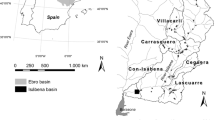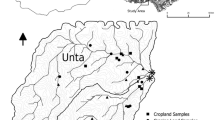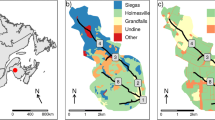Abstract
Purpose
Knowledge of sediment sources is a prerequisite for sustainable management practices and may furthermore improve our understanding of water and sediment fluxes. Investigations have shown that a number of characteristic soil properties can be used as “fingerprints” to trace back the sources of river sediments. Spectral properties have recently been successfully used as such characteristics in fingerprinting studies. Despite being less labour-intensive than geochemical analyses, for example, spectroscopy allows measurements of small amounts of sediment material (>60 mg), thus enabling inexpensive analyses even of intra-event variability. The focus of this study is on the examination of spectral properties of fluvial sediment samples to detect changes in source contributions, both between and within individual flood events.
Materials and methods
Sediment samples from the following three different origins were collected in the Isábena catchment (445 km2) in the central Spanish Pyrenees: (1) soil samples from the main potential source areas, (2) stored fine sediment from the channel bed once each season in 2011 and (3) suspended sediment samples during four flood events in autumn 2011 and spring 2012 at the catchment outlet as well as at several subcatchment outlets. All samples were dried and measured for spectral properties in the laboratory using an ASD spectroradiometer. Colour parameters and physically based features (e.g. organic carbon, iron oxide and clay content) were calculated from the spectra. Principal component analyses (PCA) were applied to all three types of samples to determine natural clustering of samples, and a mixing model was applied to determine source contributions.
Results and discussion
We found that fine sediment stored in the river bed seems to be mainly influenced by grain size and seasonal variability, while sampling location—and thus the effect of individual tributaries or subcatchments—seem to be of minor importance. Suspended sediment sources were found to vary between, as well as within, flood events; although badlands were always the major source. Forests and grasslands contributed little (<10 %), and other sources (not further determinable) contributed up to 40 %. The analyses further suggested that sediment sources differ among the subcatchments and that subcatchments comprising relatively large proportions of badlands contributed most to the four flood events analyzed.
Conclusions
Spectral fingerprints provide a rapid and cost-efficient alternative to conventional fingerprint properties. However, a combination of spectral and conventional fingerprint properties could potentially permit discrimination of a larger number of source types.







Similar content being viewed by others
References
Alatorre LC, Beguería S (2009) Identification of eroded areas using remote sensing in a badlands landscape on marls in the central Spanish Pyrenees. Catena 76:182–19
Alatorre LC, Beguería S, García-Ruiz JM (2010) Regional scale modeling of hillslope sediment delivery: a case study in the Barasona Reservoir watershed (Spain) using WATEM/SEDEM. J Hydrol 391:109–123
Appel K (2006) Characterisation of badlands and modelling of soil erosion in the Isábena watershed. Diploma Thesis, University of Marburg, Germany, NE Spain
Bayer A, Bachmann M, Müller A, Kaufmann H (2012) A comparison of feature-based MLR and PLS regression techniques for the prediction of three soil constituents in a degraded South African ecosystem. Appl Environ Soil Sci Article 2012:20
Bierbaß P, Wündsch M, Michalzik B (2014) The impact of vegetation on the stability of dispersive material forming biancane badlands in Val d’Orcia, Tuscany, Central Italy. Catena 113:260–266
Bronstert A, de Araújo JC, Batalla RJ, Cunha Costa A, Francke T, Foerster S, Guentner A, López-Tarazón JA, Mamede GL, Medeiros PH, Mueller EN, Vericat D (2014) Process-based modelling of erosion, sediment transport and reservoir siltation in mesoscale semi-arid catchments (this issue)
Brosinsky A, Foerster S, Segl K, Kaufmann C (2014) Spectral fingerprinting: Sediment source discrimination and contribution modelling of artificial mixtures based on VNIR-SWIR spectral properties. J Soils Sediments (this issue)
Chabrillat S, Eisele A, Guillaso S, Rogaß C, Ben-Dor E, Kaufmann H (2011) HYSOMA: An easy-to-use software interface for soil mapping applications of hyperspectral imagery. 7th EARSeL SIG Imaging Spectroscopy workshop, Edinburgh, Scotland
Collins AL, Walling DE (2002) Selecting fingerprint properties for discriminating potential suspended sediment sources in river basins. J Hydrol 261:218–244
Collins AL, Walling DE (2004) Documenting catchment suspended sediment sources: problems, approaches and prospects. Prog Phys Geogr 28:159–196
Collins AL, Walling DE, Leeks GJL (1998) Use of composite fingerprints to determine the provenance of the contemporary suspended sediment load transported by rivers. Earth Surf Process Landforms 23:31–52
Davis CM, Fox JF (2009) Sediment fingerprinting: review of the method and future improvements for allocating nonpoint source pollution. J Environ Eng 135:490–504
Evrard O, Poulenard J, Némery J, Ayrault S, Gratiot N, Duvert C, Prat C, Lefèvre I, Bonté P, Esteves M (2013) Tracing sediment sources in a tropical highland catchment of central Mexico by using conventional and alternative fingerprinting methods. Hydrol Process 27:911–922
Fargas D, Martinez-Casasnovas J, Poch R (1997) Identification of critical sediment source areas at a regional level. Phys Chem Earth 22:355–359
Francke T, López-Tarazón JA, Vericat D, Bronstert A, Batalla RJ (2008a) Flood-based analysis of high-magnitude sediment transport using a non-parametric method. Earth Surf Process Landforms 33:2064–2077
Francke T, López-Tarazón JA, Schröder B (2008b) Estimation of suspended sediment concentration and yield using linear models, random forests and quantile regression forests. Hydrol Process 22:4892–4904
Francke T, Werb S, Sommerer E, Lopez-Tarazon JA (2014) Analysis of runoff, sediment dynamics and sediment yield of subcatchments in the highly erodible Isábena catchment, Central Pyrenees. J Soils Sediments (this issue)
Gallart F, Solé A, Puigdefábregas J, Lázaro R (2002) Badland systems in the Mediterranean. In: Bull LJ, Kirkby MJ (eds) Dryland rivers: hydrology and geomorphology of semi-arid channels. John Wiley and Sons. Ltd, Chichester, UK
García-Ruiz JM, Nadal-Romero E, Lana-Renault N, Beguería S (2013) Erosion in Mediterranean landscapes: changes and future challenges. Geophys J Roy Astron Soc 198:20–36
Gibbs MM (2008) Identifying source soils in contemporary estuarine sediments: a new compound-specific isotope method. Estuar Coast Shelf Sci 31:344–359
Koiter AJ, Owens PN, Petticrew EL, Lobb DA (2013) The behavioural characteristics of sediment properties and their implications for sediment fingerprinting as an approach for identifying sediment sources in river basins. Earth Sci Reviews 125:24–42
Lambert CP, Walling DE (1988) Measurements of channel storage of suspended sediment in a gravel-bed river. Catena 15:65–80
Lasanta T, Vicente-Serrano SM (2012) Complex land cover change processes in semiarid Mediterranean regions: an approach using Landsat images in northeast Spain. Remote Sens Environ 124:1–14
Lawson CL, Hanson RJ (1974) Solving least squares problems. Prentice-Hall, Englewood Cliffs, New Jersey, USA, p 340
Lee D-H, Chen P-Y, J-H WU, Chen H-L, Yang Y-E (2013) Method of mitigating the surface erosion of a high-gradient mudstone slope in southwest Taiwan. Bull Eng Geol Environ 72:533–545
Legout C, Poulenard J, Nemery J, Navratil O, Grangeon T, Evrard O, Esteves M (2013) Quantifying suspended sediment sources during runoff events in headwater catchments using spectrocolorimetry. J Soils Sediments 13:1478–1492
López-Tarazón JA (2011) The sediment budget of a highly erodible catchment. The river Isábena (Ebro basin, Central Pyrenees). PhD Dissertation, University of Lleida, Spain
López-Tarazón JA, Batalla RJ, Vericat D, Francke T (2009) Suspended sediment transport in a highly erodible catchment: the River Isábena (Southern Pyrenees). Geophys J Roy Astron Soc 109:201–222
López-Tarazón JA, Batalla RJ, Vericat D, Balasch JC (2010) Rainfall, runoff and sediment transport relations in a mesoscale mountainous catchment: the River Isábena (Ebro Basin). Catena 82:23–3
López-Tarazón JA, Batalla RJ, Vericat D (2011) In-channel sediment storage in a highly erodible catchment: the River Isábena (Ebro Basin, Southern Pyrenees). Geophys J Roy Astron Soc 55:365–382
López-Tarazón JA, Batalla RJ, Vericat D, Francke T (2012) The sediment budget of a highly dynamic mesoscale catchment: the River Isábena. Geophys J Roy Astron Soc 138:15–2
Mamede GL (2008) Reservoir Sedimentation in Dryland Catchments: Modelling and Management. PhD Dissertation, University of Potsdam, Germany
Martínez-Carreras N, Udelhoven T, Krein A, Gallart F, Iffly J, Ziebel J, Hoffmann L, Pfister L, Walling DE (2010a) The use of sediment colour measured by diffuse reflectance spectrometry to determine sediment sources: application to the Attert river catchment (Luxembourg). J Hydrol 382:49–63
Martínez-Carreras N, Krein A, Udelhoven T, Gallart F, Iffly JF, Hoffman L, Pfister L, Walling DE (2010b) A rapid spectral-reflectance based fingerprinting approach for documenting suspended sediment sources during storm runoff events. J Soil Sediments 10:400–413
Martínez-Carreras N, Krein A, Gallart F, Iffly JF, Pfister L, Hoffmann L, Owens PN (2010c) Assessment of different colour parameters for discriminating potential suspended sediment sources and provenance: a multi-scale study in Luxembourg. Geophys J Roy Astron Soc 118:118–129
Ministerio de Agricultura, Alimentación y Medio Ambiente/Confederación hidrográfica del Ebro (n. d.): Geología Dominio Sinclinal de Tremp 1:50,000
Ministerio de Medio Ambiente y Medio Rural y Marino (MARM) (2008) Mapa de cultivos y aprovechamientos, Madrid, Spain 1:50,000
Morgan RPC (2005) Soil erosion and conservation, 3rd edn. Blackwell Publishing Ltd, Oxford, UK, 304 pp
Mukundan R, Walling DE, Gellis AC, Slattery MC, Radcliffe DE (2012) Sediment source fingerprinting: transforming from a research tool to a management tool. J Amer Water Resour Assoc 48:1241–1257
Navratil O, Evrard O, Esteves M, Legout C, Ayrault S, Némery J, Mate-Marin A, Ahmadi M, Lefèvre I, Poirel A, Bonté P (2012) Temporal variability of suspended sediment sources in an alpine catchment combining river/rainfall monitoring and sediment fingerprinting. Earth Surf Process Landforms 37:828–846
Owens PN, Batalla RJ, Collins AJ, Gomez B, Hicks DM, Horowitz AJ, Kondolf GM, Marden M, Page MJ, Peacock DH, Petticrew EL, Salomons W, Trustrum NA (2005) Fine-grained sediment in river systems: environmental significance and management issues. River Res Applications 21:693–717
Parsons A (2012) Interactive comment on “Influence of basin connectivity on sediment source, transport, and storage within the Mkabela Basin, South Africa” by J. R. Miller. Hydrol. Earth Syst Sci Discuss 9:C4345–C4347
Piqué G, López-Tarazón JA, Batalla RJ (2014) Variability of in-channel sediment storage in a river draining highly erodible areas (the Isábena, Ebro Basin). J Soils Sediments (this issue)
Poulenard J, Perrette Y, Fanget B, Quetin P, Trevisan D, Dorioz JM (2009) Infrared spectroscopy tracing sediment sources in a small rural watershed (French Alps). Sci Total Environ 407:2808–2819
Poulenard J, Legout C, Némery J, Bramorski J, Navratil O, Douchin A, Fanget B, Perrette Y, Evrard O, Esteves M (2012) Tracing sediment sources during floods using diffuse reflectance infrared Fourier transformed spectrometry (DRIFTS): a case study in a highly erosive mountainous catchment (Southern French Alps). J Hydrol 414–415:452–462
Savitzky A, Golay MJ (1964) Smoothing and differentiation of data by simplified least square procedures. Anal Chem 36:1627–1639
Smith HG, Blake WH (2014) Sediment fingerprinting in agricultural catchments: a critical re-examination of source discrimination and data corrections. Geophys J Roy Astron Soc 204:177–191
Valero-Garcés BL, Navas A, Machin J, Walling D (1999) Sediment sources and siltation in mountain reservoirs: a case study from the central Spanish Pyrenees. Geophys J Roy Astron Soc 28:23–41
Verdú JM (2003) Análisis y modelización de la respuesta hidrológica y fluvial de una extensa cuenca de montaña mediterránea (río Isábena, Pre-Pirineo). Dissertation, University of Lleida, Spain
Viscarra Rossel RA, Minasny B, Roudier P, McBratney AB (2006) Colour space models for soil science. Geoderma 133:320–337
Walden J, Slattery MC, Burt TP (1997) Use of mineral magnetic measurements to fingerprint suspended sediment sources: approaches and techniques for data analyses. J Hydrol 202:353–372
Walling DE (2005) Tracing suspended sediment sources in catchments and river systems. Sci Total Environ 344:159–184
Wyszecki G, Stiles WS (1982) Color science: concepts and methods, quantitative data and formulae, 2nd edn. Wiley, New York, USA
Acknowledgments
This research was carried out within the project “Generation, transport and retention of water and suspended sediments in large dryland catchments: Monitoring and integrated modelling of fluxes and connectivity phenomena” funded by the Deutsche Forschungsgemeinschaft (DFG). The 4th and 5th authors were supported by the SCARCE-CONSOLIDER project (ref. CSD2009-00065) funded by the Spanish Ministry of Economy and Competitiveness. The authors would like to thank Arne Brauer, Benjamin Kayatz, Iris Kleine and Charlotte Wilczok from the University of Potsdam for their support of field work and Stefan Lips and Heide Kraudelt for their support of laboratory measurements. The authors also wish to thank the Ebro Water Authorities for the permission to install the measuring equipment at the Capella gauging station and for providing hydrological data.
Author information
Authors and Affiliations
Corresponding author
Additional information
Responsible editor: José Carlos de Araújo
Electronic supplementary material
Below is the link to the electronic supplementary material.
Electronic Supplementary Material 1
Discharge at Capella weir over the study period including sampling dates for resuspension samples (circle) and suspended sediments during storms (thick lines) (PDF 91 kb)
Rights and permissions
About this article
Cite this article
Brosinsky, A., Foerster, S., Segl, K. et al. Spectral fingerprinting: characterizing suspended sediment sources by the use of VNIR-SWIR spectral information. J Soils Sediments 14, 1965–1981 (2014). https://doi.org/10.1007/s11368-014-0927-z
Received:
Accepted:
Published:
Issue Date:
DOI: https://doi.org/10.1007/s11368-014-0927-z




